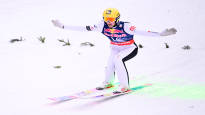When sports enthusiasts are asked to list the single most memorable Finnish sports performances of the last decade, the events of January 4th in 2014 rank high on many papers.
At that time, a significant moment was experienced in skiing, which was of interest to large groups of people, when Anssi Koivuranta won first place in the Innsbruck competition of the Central European Hill Week.
The result raised a glimmer of hope for the new rise of the nationally successful sport after the 2011–2013 Alho seasons – at that time, the Finnish hillmen did not reach the podium once in the World Cup.
In the spring of 2014, in addition to his win in Innsbruck, Koivuranta reached the top ten in the Cup six more times and was fifth after the first round of the Sochi Olympics (11th in the final results).
However, the results did not fill the sponsorship portfolio of the Ski Federation in the following seasons.
Jump to today. On Saturday Niko Kytösaho goes to the final day of the individual competition at the Lentomäki World Championships in seventh place. After two rounds of the four-jump competition, Kytösaho’s gap to the World Championship bronze is a paltry 9.2 points.
Kytösaho has been at best 19th in the World Cup this season, and the best ranking of his career is last winter’s 16th place. The 24-year-old jumper of Paimio Urheilijode is therefore in many ways on unknown ground.
However, Kytösaho’s chances of success are helped by the certainty found at the Kulm airfield: the training jumps preceding the two competition jumps were also top-level. The 232.5-meter jump in Kytösaho’s opening round ended up being the longest jump of the entire competition day on Friday.
Dependent on individual supporters
If Kytösaho managed to win a medal on Saturday, the effects of the performance could be huge in Finnish skiing.
So far, the Ski Association has only one sponsor that brings a significant amount of money to the coffers of ski jumping. Among other things, an Austrian company that manufactures heat pumps has supported Finnish ski jumping from autumn 2022 with a four-year contract worth approximately 250,000 euros annually.
According to Urheilu’s information, the Ski Association currently has no other sponsors in ski jumping that would reach even a fifth of the Austrian company’s investment on an annual basis.
The situation is not new. In the years 2018–2022, the main responsibility for the financing of Finnish ski jumping was borne by a domestic furniture company, whose annual bill was around 200,000 euros. Even then, it was quiet behind the main sponsor.
Before Kytösaho’s performances on Friday, the results of the Finnish mountain men have been at the level of recent years, with the exception of individual successes. This is despite the fact that the leading countries have one less jumper than before in the competitions due to the rule reform for this season.
Earlier in January Jenny Rautionaho achieved the women’s hill country team’s first World Cup podium finish in ten years when she finished second in Sapporo.
From the ski association’s point of view, however, the effects of Kytösaho’s success would be manifold.
The key role of hill jumping
Men’s ski jumping is in a class of its own when you compare the media and marketing contracts of the Nordic skiing sports.
According to Urheilu’s sources, the compensation paid for the Men’s Ski Jumping World Cup competition is currently between 350,000 and 400,000 euros. In men’s combined, the amount is about a third. When you add up the contract values for men and women in cross-country skiing, you arrive at about half the value of men’s ski jumping. The media compensation for women’s ski jumping is not even a tenth of the amount for men.
If there is no men’s ski jumping, in the current system the Ski Association cannot make a profit from the Ruka and Lahti World Cups. The International Ski Federation FIS also doesn’t think it’s good that the Finnish skiers find their way to the side of the slope, but the Finns on the hills can be counted one by one during the competition.
Behind the weak audience numbers have naturally been the lackluster results of Finnish male ski jumpers. For this reason, especially Lahti’s position in the mountain calendar has been threatened. For FIS, low audience numbers are not a problem in cross-country skiing, but the situation is different in the number one product of Nordic skiing.
– The return of the Finnish mountain man to the top fight is the wish of the entire international sports community, a skiing insider states and underlines:
– Ten years ago, Koivuranta’s victory and good results did not materialize into money, partly because the successful years of domestic ski jumping were still so close.
The source refers To Ville Larintowho won the World Cup competition on December 1, 2010. In the 2010–2011 season in question, Larinto and Matti Hautamäki appeared on the podium twice to a man.
– The Finnish mountain man’s return to the top fight has been awaited year after year. If that were to happen, the best thing in the current situation would be for Finland to have a potential success in both men and women. It is important in the negotiations, the source says and signs that Kytösaho’s performances on Saturday are talking about a potential million-dollar day, taking into account possible sponsorship income and the value of the existing World Cup rights.
